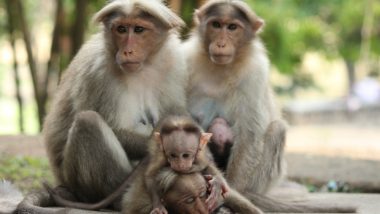Cases of Kyasanur Forest Disease (KFD), a tick-borne viral fever, are suddenly on the rise after 20 people from Shimoga district in Karnataka were diagnosed and six died from the illness. Known locally as Monkey Fever or Makad Taap, KFD was first identified in the Kyasanur Forest area of Karnataka, which inspired the name. The fever has reportedly spread to Wayanad district in Kerala after one case was confirmed and the other is awaiting confirmation. An alert has been issued in Kerala, and the neighbouring state of Maharashtra has been taking measures to contain the spread of the disease.
What is Kyasanur Forest Disease or Monkey Fever?
KFD is a tick-borne disease spread by the Flaviviridae virus. According to the Center for Disease Control and Prevention (CDC), the disease is named after the virus isolated from a sick monkey from the Kyasanur Forest in Karnataka. And as of today, 400-500 cases of the disease have been detected. Monkey Fever Afflicts Goa: 35 People Infected in Goa’s Sattari Taluka.
Hard ticks called Hemaphysalis spinigera harbour these viruses and remain infected for life. These ticks feed on rats, mice, shrews and monkeys, who become infected by the virus.
KFD is transmitted to humans through tick bites or contact with infected animals. As of today, no cases person-to-person transmission has been identified.
What are The Signs and Symptoms of KFD or Monkey Fever?
The symptoms of the disease start showing within three-to-eight days after an incubation period. The symptoms are as follows:
- Chills
- Fever
- Headache
- Severe muscle pain
- Vomiting
- Gastric problems
- Bleeding
- Low blood pressure
- Low platelet count
- Low red blood cell count
- Low white blood cell count
A week or two after the symptoms, some patients recover without complications. According to CDC, the disease is biphasic (happening in two phases) for a small group of patients (10-20%). They experience a second wave of the symptoms at the beginning of the third week. These signs include:
- Severe headaches
- Mental disturbances
- Tremors
- Vision deficits
CDC says that the estimated case-fatality rate for KFD is three to five percent.
Who’s at Risk?
As per records, cases of KFD has been seen only in western and central districts of Karnataka, India. But in recent years, instances of monkey fever has been seen in Tamil Nadu, Kerala and Goa.
People who are involved in occupations where there is a risk of coming in contact with infected animals and ticks, are at greater risk. These include hunters, gatherers, farmers, forest workers, veterinarians, etc.
There is usually a spike in cases during the dry season, from November till June.
How is KFD Treated?
Most of the treatment for KFD requires early hospitalisation and supportive therapy. This includes proper hydration and support for people who have bleeding disorders due to low platelet count.
How To Prevent KFD?
The disease can be prevented through vaccination. Apart from immunisation, wearing protective clothing, and controlling tick and mosquito population are effective ways to prevent the disease. There’s no specific way to treat the disease.
(The above story first appeared on LatestLY on Jan 24, 2019 11:26 AM IST. For more news and updates on politics, world, sports, entertainment and lifestyle, log on to our website latestly.com).













 Quickly
Quickly


